Terrill Welch by herself - issue #29 Beginning of Floating Arrangement Painting

Refusing to be stalled by gardening disruptions, Canadian election considerations, income tax filing, stock market volatility or tariff debacles, I have kept going this month with reference gathering and painting in the studio. These efforts will all count towards my next Unit, should I successfully complete the first Unit towards my MA in Fine Art. We are still a month away from knowing the outcome of my formal assessment. I started out with one modest “landscape of the small” painting and have now begun a large 48 x 40 inch canvas. The subject is a floating arrangement of shells and small stones lifted gently off the seafloor by an incoming tide.
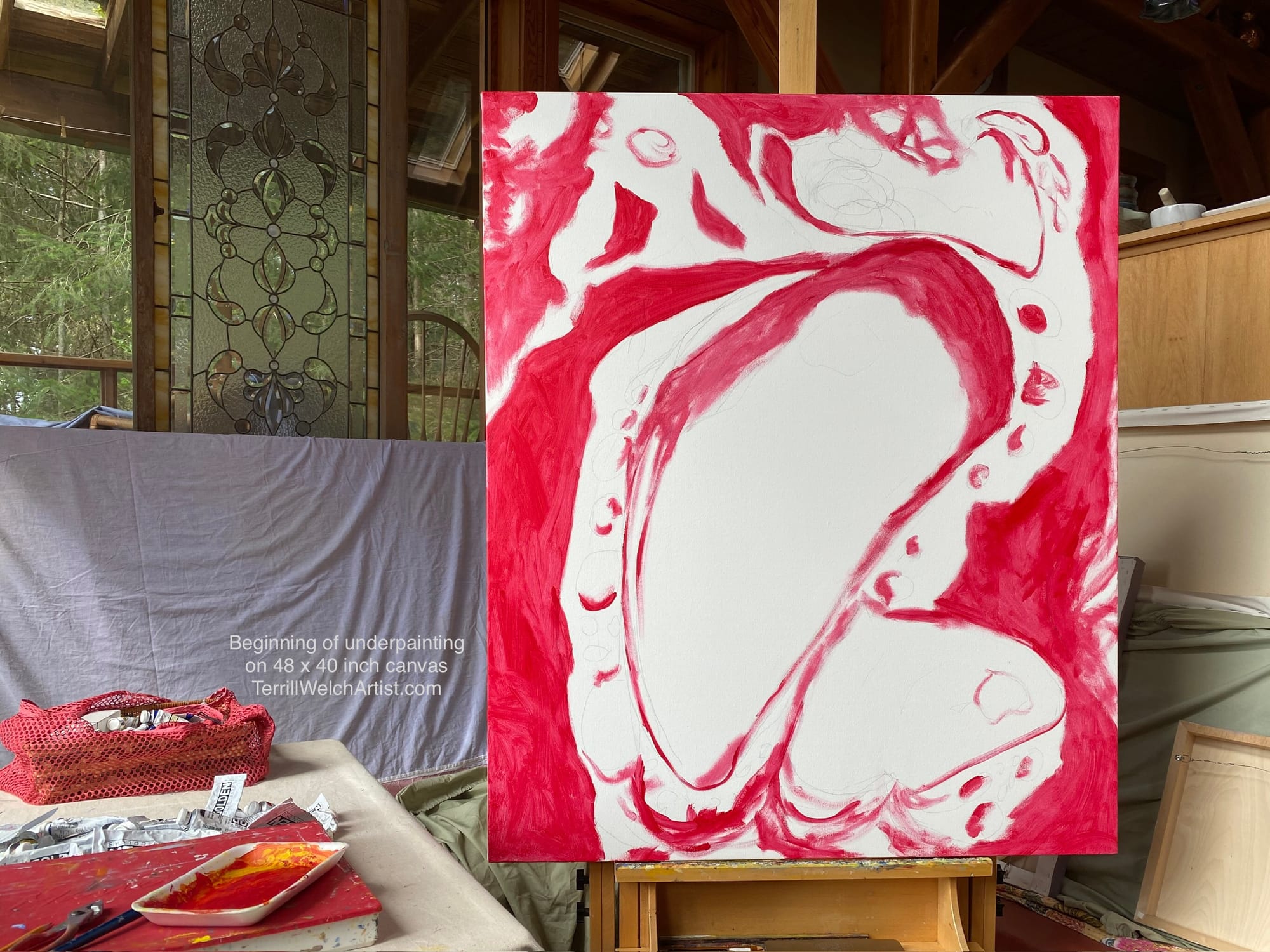
I had seen single shells and bits of shells floating before but never such a perfect inspiring arrangement.
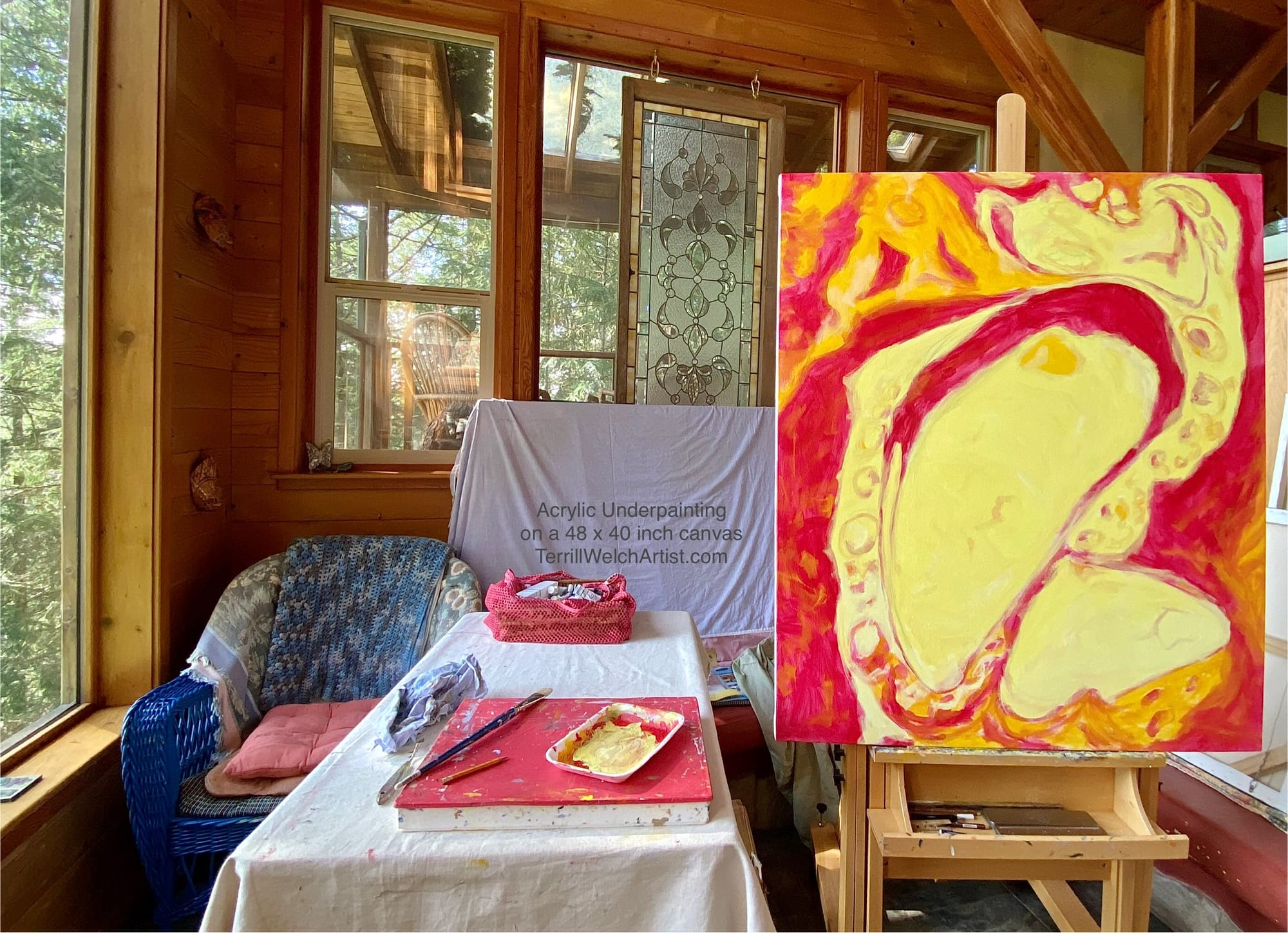
I am attempting to video as I go along but it is not going so well because I just want to work and recording is extremely disruptive to my painting zone. On top of that, I don’t really have much to say in words… only brushstrokes.
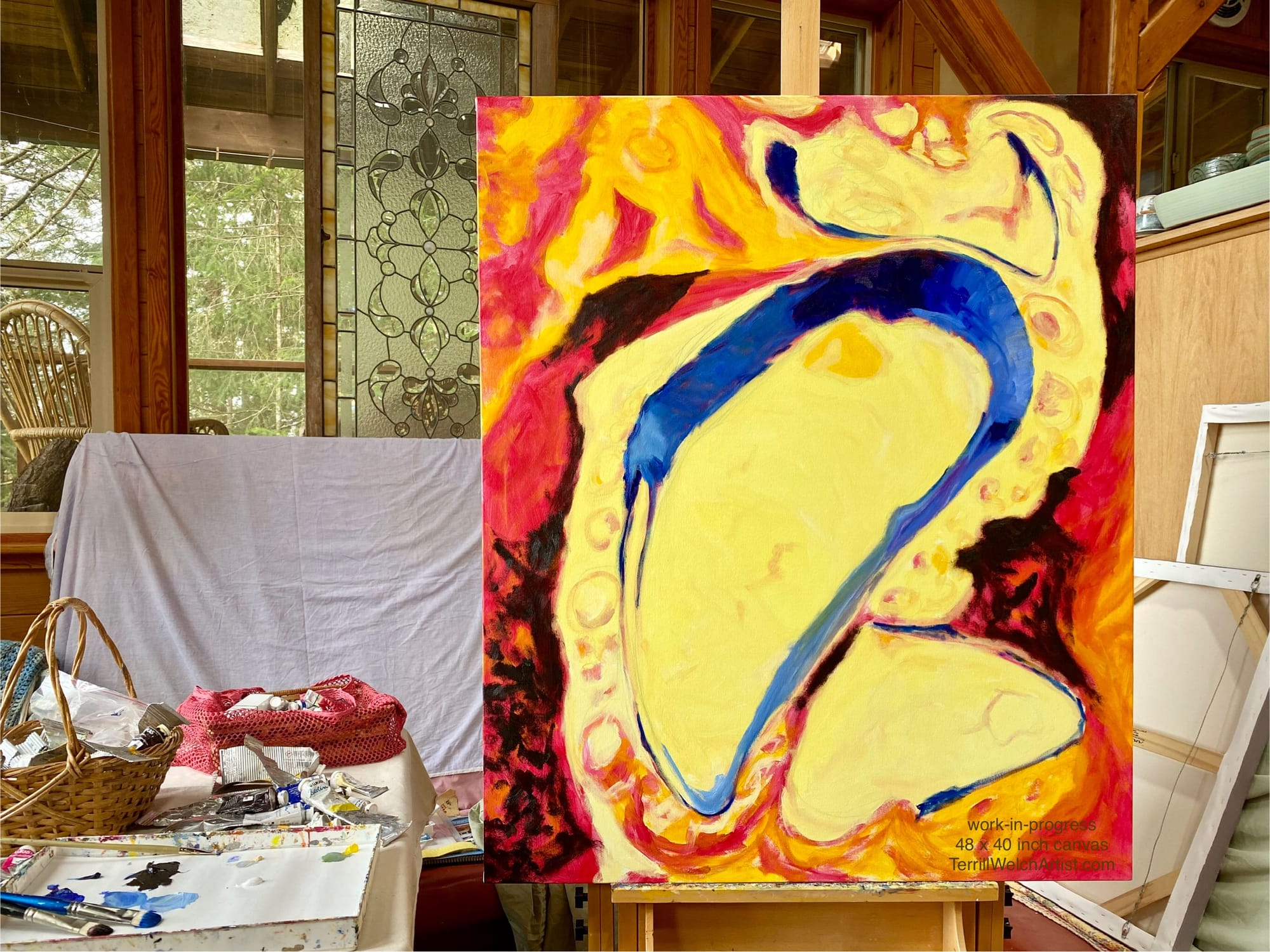
I didn’t get any further on this before this newsletter is to be published but I will share more next issue.
AND you won’t want to miss your early access to my Token of Appreciation savings! Keep reading all the way the end. 😉
LEAVING SOMETHING BEHIND – PAINTING PROCESS
I was asked recently in a forensic review of my painting process by one of our tutors, why do I stop and take an in-progress image when I do? I didn’t have an answer, never mind a good answer. The tutor found the still areas, when the ground was still showing in my paintings, interesting and worth further consideration. I replied that she wasn’t alone and sometimes I resisted showing these stages because it wasn’t the drama with the ground I was seeking to express in my work. Her response was, maybe it isn’t the colour so much as the patches of smooth colour? Maybe it could be any colour? I concede that this is a possibility worth considering. How, having finished this latest work, I am thinking there are other ways to provide stillness in a lively painting through the atmosphere rather than flat patches of paint. But we shall see. I enjoy being asked question about my painting process that I cannot answer right away. They become challenges or painting problems to be resolved. Anyway, I thought I would share various aspects of my making process, starting with tile columns of notes from beginning to end…

This image is to be read like a newspaper from top left down and then up and across to the next column and down, until you end up with the image of the final painting in the bottom right corner. I begin with my field notes and then ask myself, how have these influenced the final painting? Is there anything noteworthy in the places where I stopped to collect an in-progress image? What do you think? Do you notice anything that I should pay attention to or bring into my awareness?
I usually just walk slowly on the shore of Reef Bay looking down and out and down and out again along the reefs until something catches my attention, like the dark purple pattern patches in this shell.

Sometimes, I carefully pick up and examine it closely before putting it back where I found it.

Another times, I look into crevices between the rocks and see what has been left behind.
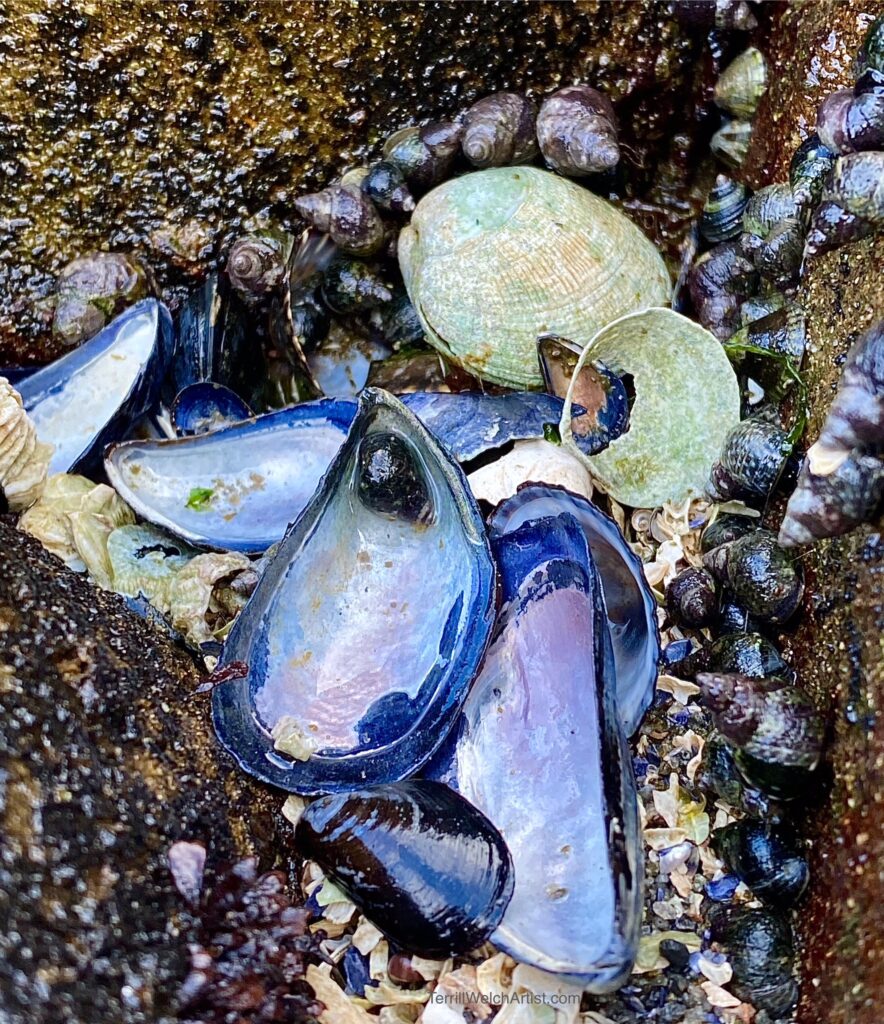
But it is usually not just one image taken of any particular observation. This exploration goes on in a cluster of observations, usually resulting in a few dozen photographic sketches being added to my reference folder to remember shapes, sounds, smells, colours, textures and the rhythms of a place on a specific day.
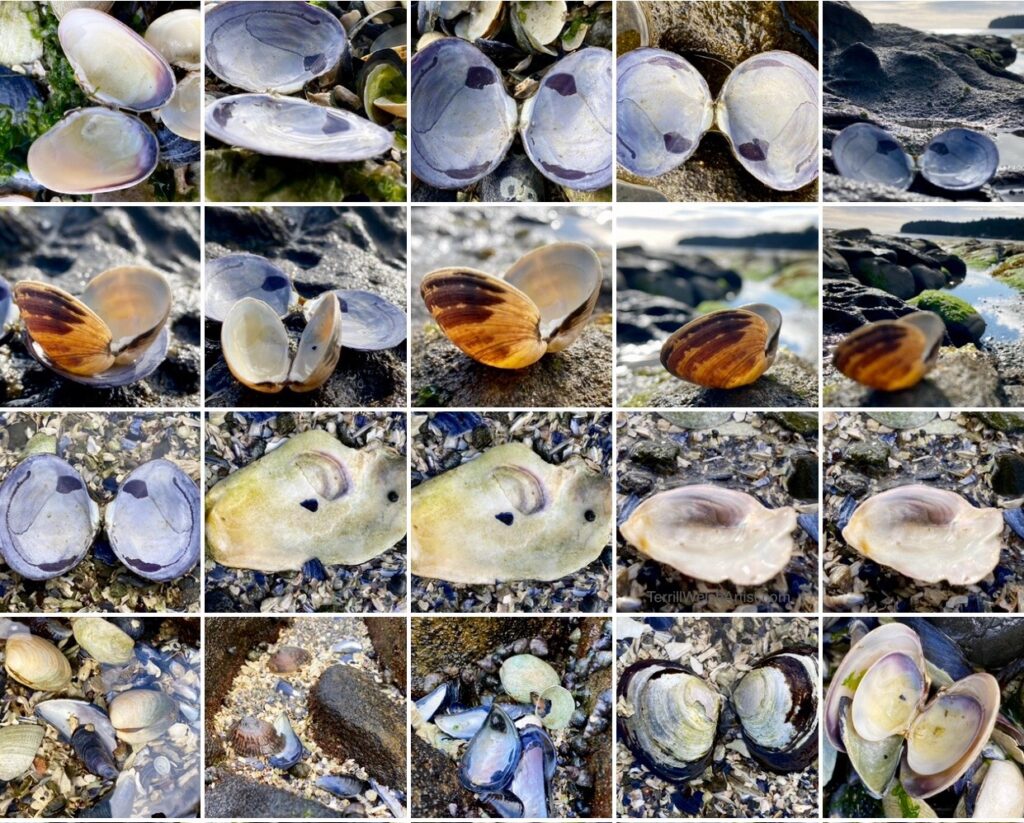
Collage of photographic sketches gathered at Reef Bay on Mayne Island for later reference in the studio.
Then, I come back to the studio and decide on a surface to begin. This time it is a 12 x 10 inch canvas with a red acrylic ground and 1.5 inch edges that will need to be painted later on. I use a few of my images to imagine the composition and capture it in a rough line drawing on the canvas. I wanted to get that lime yellow green of the seaweed down first. It is the brightest part of the land and will have to carry the connection between sky, sea and sandstone with the shells in between.

Now, if you followed the process in the first tile columns collage image, you will see that I work back and forth between light and dark areas until I can loosely paint in the shells and small pebbles to be cradled within this tension of value space. It is like breathing in and out with my brush as I step back and forth from the easel, by using my memory and feeling my way into the moment as it is gathering itself up on the canvas.

Detail images reveal clusters of fluid directional brushstrokes.

Detail - ‘Leaving Something Behind’ by Terrill Welch, 12 x 10 inch walnut oil on canvas.
They are laid down in rhythms as if washed in and out of existence, not unlike the actions of sea.

Detail - ‘Leaving Something Behind’ by Terrill Welch, 12 x 10 inch walnut oil on canvas.
Bits of the red ground still show through and offer a chance to vibrate the energy of the greys, greens and blues in the finished painting.

Detail - ‘Leaving Something Behind’ by Terrill Welch, 12 x 10 inch walnut oil on canvas.
My intent is to leave brush marks behind that remind me of the smells, sounds and textures of this moment and this place rather than just visual clues that only represent what our eyes can see.

Still, no one part of the canvas is meant to be taken in by itself. It is the whole of the work that brings the moment into a full conversation for me. The pauses and stillness are with the reflection on the still sea rather than patches of flat smooth colour. The drama of the red ground is purposefully tucked underneath to hint at brilliance rather than shout. Does it work? I think so in the sense that it captures what I intended.
This painting is now released and can be more fully considered at:
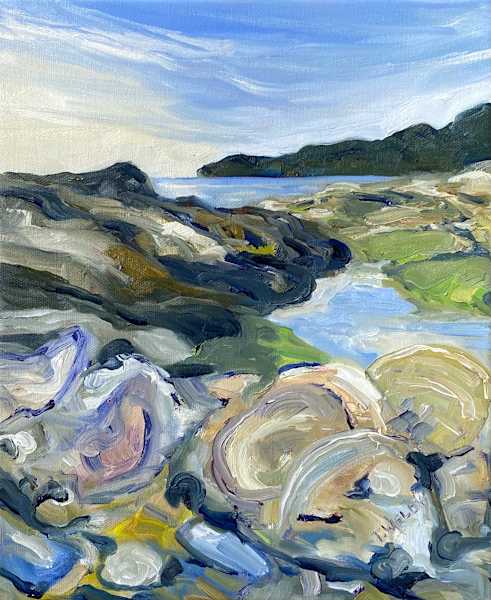
SEAFLOOR STUDY WITHIN TIME AND SPACE
Thursday, 11 April 2025
I was walking through the seaside trails the other day and thinking about how I came to be studying the seafloor. I didn’t just wake up on day and decide that seaweed, seashells and ‘landscape of the small’ would be the most amazing subject for painting. I could have maybe but I didn’t. Instead, it was an evolution of observation and restrictions that has brought me to this place. Let’s go through the day and see if we can learn more through reflection as I walk, live and explore.
I have always liked to photograph the spring and summer wild flowers. Today I cam across my first Calypso Orchids on the Saint John Point trails.

They are worth a close study both for their delicate structure and beautiful scent.

I have yet to paint these wildflowers. Maybe someday.
The arbutus trees out on the point is another story. They have come under my brush many times. When I walk among them, these works often map onto what I am seeing. Here is just one example.



Other times I notice a composition I had ‘t considered before. I ask myself, what might I beat.e to do with this?

The hike is only a little over 4 km long but by the time I amble over the uneven ground along the cliffs sitting and observing now and again, it generally takes me about 2 hours. On this day, I had my eye out for as many wildflowers as I could find. Down over the steep cliff side were sedum growing in locations where the deer couldn’t reach them. Hence, neither could I.

However, I did find some between the rocks that were safely within my reach.

The trail is not really the same each visit as the light is unique offering distinct formation to be pronounced in the landscape.
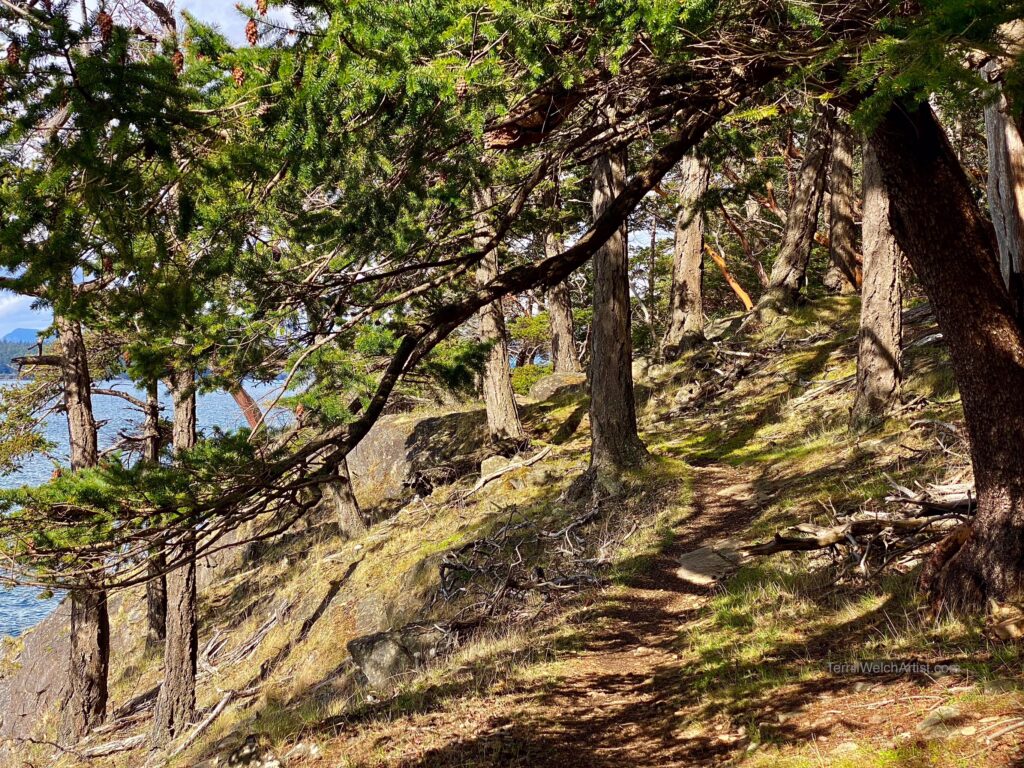
I continue on until I spot two more patches of small wildflowers.


Then finally a perfect yellow beauty that we all know…

You might be thinking, yes but what does this have to do with my study fi the seafloor? I wondered the same and have come to the conclusion that just as I observe both the landscape and the forest floor, it would make sense that eventually I would observe the seafloor as well as the seascape and shoreline.
I came home and made us current and orange scone biscuits.

These were served still warm with cheese and strawberries.

My stepson has been visiting and was staying with my husband so I could be gone for longer than I was usually comfortable leaving him alone these days. A special lunch seemed like a nice token of thank you.
It might seem odd to add in the making of lunch to my post about my creative practice but it is somehow thoroughly embedded as part of a complete representation of how I live and work with the best moment, the best materials and the best ingredients I am able to gather and experience. Making lunch is part of living purposefully in a considered way during the fullness of my making day.
I am still puzzling about how I came to be interested in the seafloor and asked my husband if he wants to come out to Reef Bay with me for a while. He was game and trundled his outside walker to the car in record speed. Reef Bay is ideal for us because I can drive right up to the edge of the beach where he can then stay in the car and still see what is going on and keep an eye on me as I clamber around on the sandstone reefs. The tide is still quite a way out but on its way in and the sea is still.
I start by gathering a few ‘child’s view’ photographic sketches of shells.
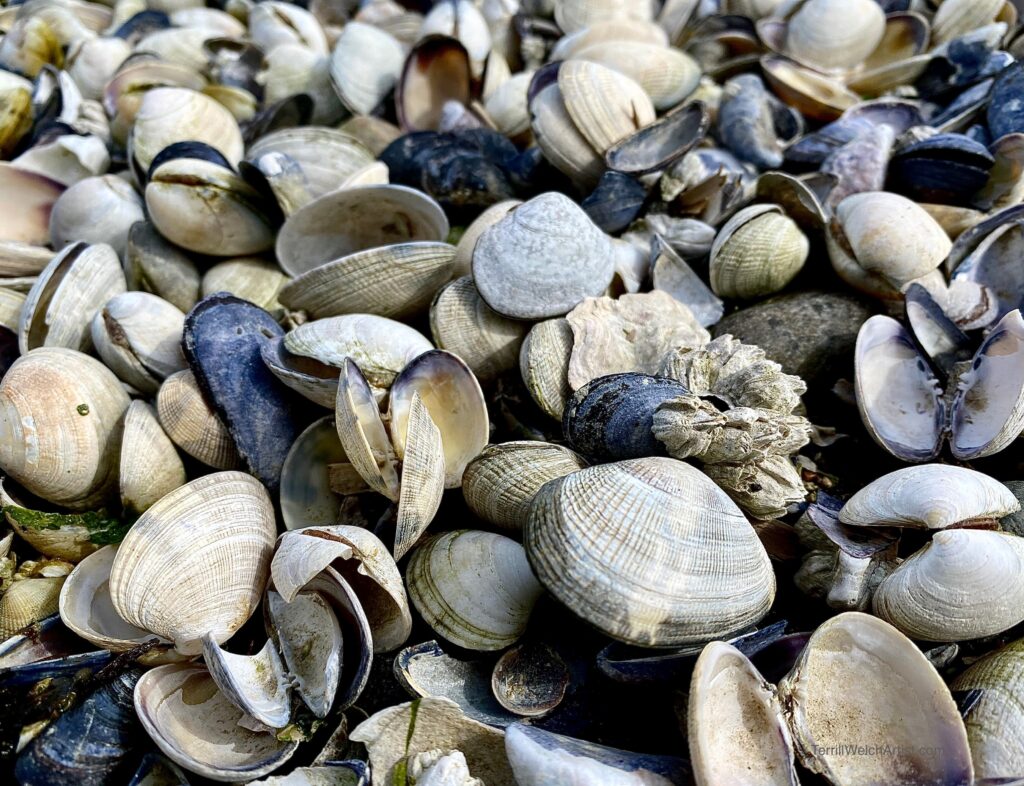
It is my way of warming up and settling into the moment.

Shapes and colours seem to frame themselves freely behind the lenses of my iPhone.

But then I begin to get lower yet and frame up a ‘landscape of the small’ that offers more contextual environment to the shells.

This reminds of the first painting I have done for the second Unit which is shared above.

The top of the main reef has dried in the wind and sun that after a few Spring days clears it of slippery seaweed. I walk out as far as I can.

It is not far as we can see when I turn back towards the shore.

I gather photographic sketches of shells and seaweed in various small environments on both my way out and back.
An old oyster shell caught under the incoming tide.

Another oyster is a little farther below the surface of the sea in the cracks between the rocks.

These feel like half finished abstract works to me. I am not sure I can bring anything more to them with paint. Yet, they somehow record information that feels important even if it is never used directly.

I find that it is significant to capture this quieter process of sea and shore meeting… more of a slow caress than a heartbeat and breath rhythm of rolling waves.
Then I spot this cluster of shells floating in an immediately enthralling composition. This I can see putting to paint on a canvas! I have seen these before but never so visually and sensory complete and, most importantly, I can get close enough to document my discovery.

I have been working for months to capture something like this! Ta-da! It will be such a pleasure to unravel the mysteries of these shapes and the movement of the sea around the forms of the shells. This I can do something with!
I continue on, enjoying the colours do the limpid shells.

I notice layers and patterns of sandstone and sea with the rising tide.

Another old oyster shell captures briefly my attention.

However, I am still remembering that cluster of floating shells and thinking about what size of canvas I should use to paint it, maybe large so I can keep it longer.
Going back to my original question about how I have come to study and paint the seafloor, I have tentative answers. Since 2020, I have been required to stay close to home. First, because of the pandemic and second, because of my husband’s health. I deliberately decided early on to focus on what I can do rather than what is temporarily not easily possible. If I wasn’t going to be able to travel to paint then I was going to need to learn how to thrive in place. I challenged myself to go deeper rather than further. To this end, in late 2021 until near the end of 2023 I painted a series called ‘Thriving in Place’ that can be viewed at:
https://www.artworkarchive.com/profile/terrill-welch/collection/thriving-in-place
These physical restrictions in my life and meeting them with a thriving challenge has resulted in learning and living on the land beside the sea in new ways with an even greater appreciation. In hindsight, it seems obvious that I would eventually tackle painting the seafloor rather than just the seascape. What I have come to understand over these past few years is that deep learning and observation is as limitless and endless as travelling and gathering a breadth of understanding. In the end, thee is no great mystery to unveil in my decision to study the seafloor. Rather, it is a continuation of painting expression that captures my regard and respect for our earthly existence.
WHAT I HAVE BEEN WATCHING
The news, as you well know, has been most disturbing 😳 and I am not going to focus any of our attention on these important, yet distracting, events. Instead, I want to keep us in a place of pauses that offer hope and a chance at resilience. This is one of my superpowers… being able to bring myself (and hopefully you as well) around from despair to possibility.
I have discovered an artist living in Portugal whose perspective on resonates with my own though her approach to painting and making practice are very different. Still, I found these two short videos about the life and work of Deborah Osberg refreshing. Osberg has a PHD in Educational Philosophy and Master’s of Science in Zoology and has focused on her art practice more recently. Here is a little more about her artwork before I share the videos:
Deborah Osberg is a South African artist currently living in Portugal. Her artistic focus has grown from a career as an educational theorist in Britain, following her experiences of colonising forces while living and working as a white zoology lecturer in apartheid and post-apartheid South Africa. Her art explores tensions within political systems of power and control.
Osberg uses acrylics, charcoal, chalk, ink, wax, rust and fragments of academic text to create richly textured surfaces that reveal traces of what is hidden beneath. The rawness of her artistic process is integral to her work: tearing, layering, and juxtaposing fragments of academic texts—both her own and those of others—into disjointed arrangements that evoke a sense of rupture and resistance. She paints over, censors, or obscures texts. The resulting compositions are not merely visual narratives but tactile experiences that invite the viewer to question what is shown and what is concealed. (Biography from her website at: https://www.deborahosberg.com/about )
Each video is about 15 minutes long.
And here is the second one…
There is another artist whose philosophy also has caught my attention and this is contemporary abstract artist David Mankin in Cornwall, England. I was referred to Mankin by a fellow artist who knows my work well. Even if you have little affinity with abstract painting, I think you will enjoy this glimpse into his life and creative process from six years ago. Again, this is a short 14 minute clip.
Though neither of these artists in the videos have much to do with my own physical expression of painting, their approaches to life and an observation led creative practice resonates. They are a great reminder that a subject can be approached using various methods and the renderings can still hold its integrity.
NEW SHOWS IN GALLERY POD AND SUNNY MAYNE BAKERY
The Terrill Welch Gallery Pod will be featuring ”Along the Salish Sea Shore” for the next while with the inclusion of many of my Seafloor and Seashell paintings completed over the past eight months.
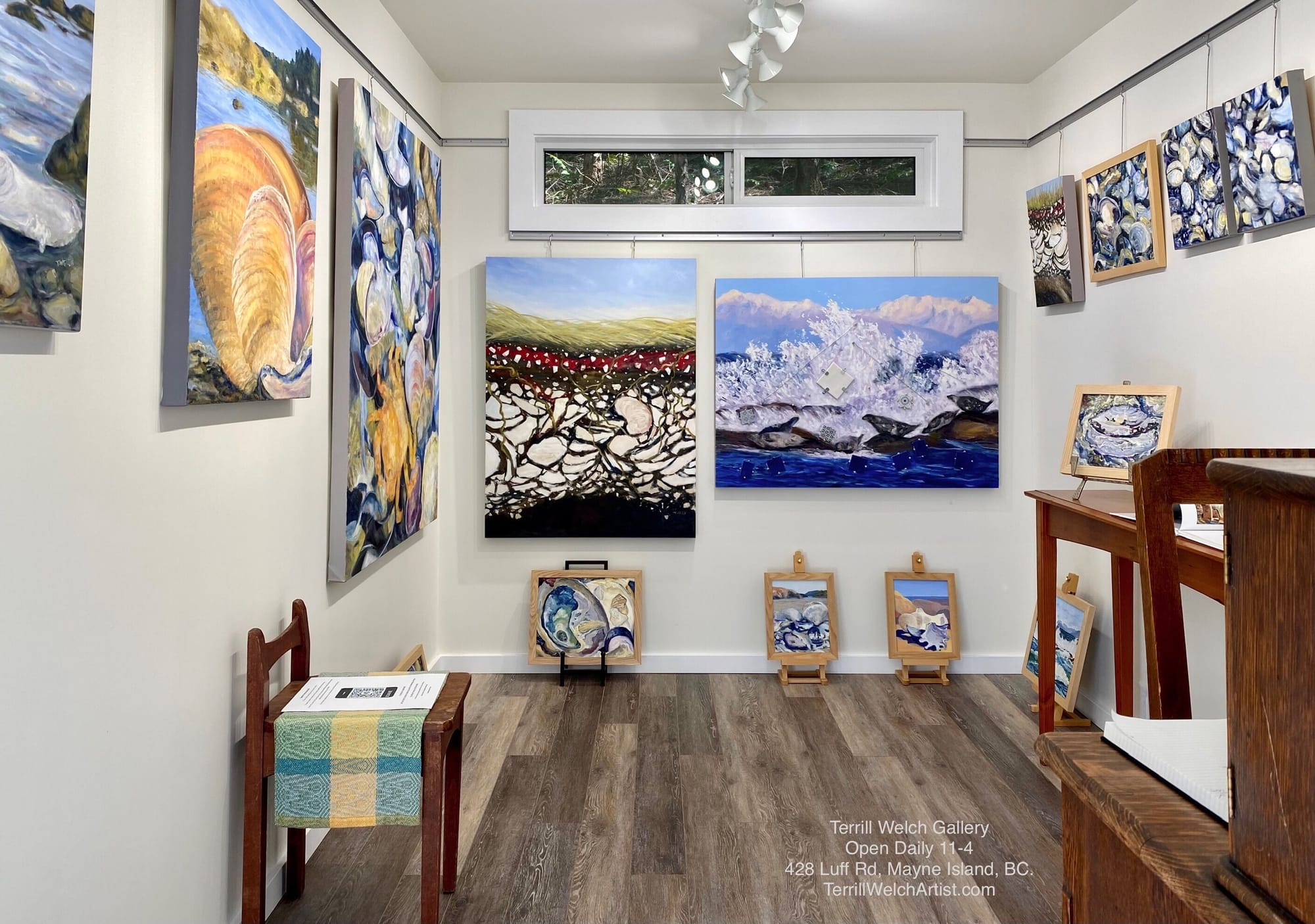
Do take a look in the private viewing room linked below:

In addition, I am is excited to present an ongoing small exhibition featuring her paintings in the Sunny Mayne Bakery Café. This show will change every few months to offer fresh explorations of themes and ideas presented in her Mayne Island painting practice. Thank you to Emily and Shem for this generous opportunity and their ongoing support of our Mayne Island community!
This current show features “The Joy of Living on Mayne Island” from arbutus trees, splashing waves in the sun, spring blossoms and summer flowers resulting from special still life project 2024 when flowers were delivered to the studio every two weeks from our local Hardscrabble Farm.

UP COMING TOKEN OF APPRECIATION SAVINGS
You would be right if you think I have been stalling on my hinted Spring savings. However, I am now ready to proceed, with or without tariff and global markets clarity. ARTSY has captured some of this tariff confusion for art in a recent article for galleries and art collectors:

I am therefore still reluctant to ship to the United States but will do so following a personal discussion with the purchaser about possible unknown or unexpected tariff impacts.
For everyone else in Canada and the world your request to purchase can easily be fulfilled!
Therefore, all things being equal, a public offer for a Token of Appreciation savings will begin on Friday May 16, 2025 with a 10% savings on all available original paintings with an additional 10% savings for those subscribed to this newsletter. In addition, if you are already an art collector of my paintings, then your art collectors savings will, as usual, also apply. When all is said and done, this can result in a nice savings of at least 20% for those of you receiving “Terrill Welch by herself”. The best part is as a subscriber, you do not have to wait. These Token of Appreciation savings are available to you now and are available until the end of the special public offer Friday May 30, 2025.
Go ahead and have a look! I am thrilled to be able to offer you this Token of Appreciation savings. Be the first to browse everything that is currently available for consideration in my online gallery at:

Remember to select “Available” at the top right as I have completed over 500 paintings since 2010 and only 157 still available. Though they are not all visible, you do not need to be continually disappointed by viewing paintings that have already been sold. Do contact me directly via email at tawelch@shaw.ca if you have any questions or require personalized assistance.
UNTIL NEXT TIME!
It is Good Friday and Easter Weekend. I wish you an engaging time with family and friends as you acknowledge the weekend in whatever way is right for you. If you do not get a chance until sometime later next week to read through this latest issue, that it is okay. There is no firm “best before date” and I will be happy to receive your comments and emails anytime.
A quick reminder that as a newsletter subscriber, you have access now to my “Token of Appreciation savings” offer presented earlier in the publication. We each need to do what we can to create a thriving path forward. This is one contribution that I can make and I thank you sincerely for your ongoing support and patronage!
Warm regards and all the best as usual.
Terrill 👩🎨💐❤️
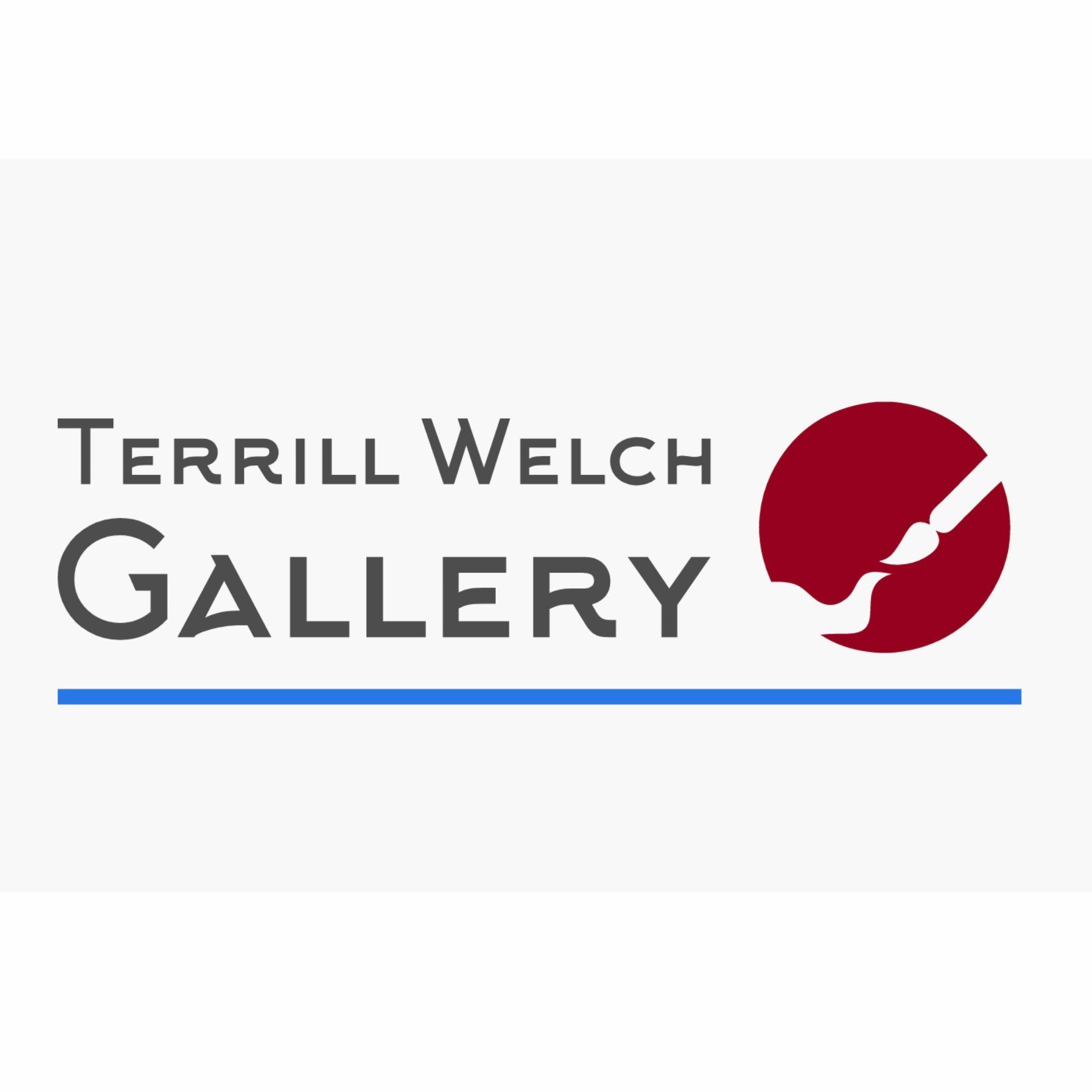





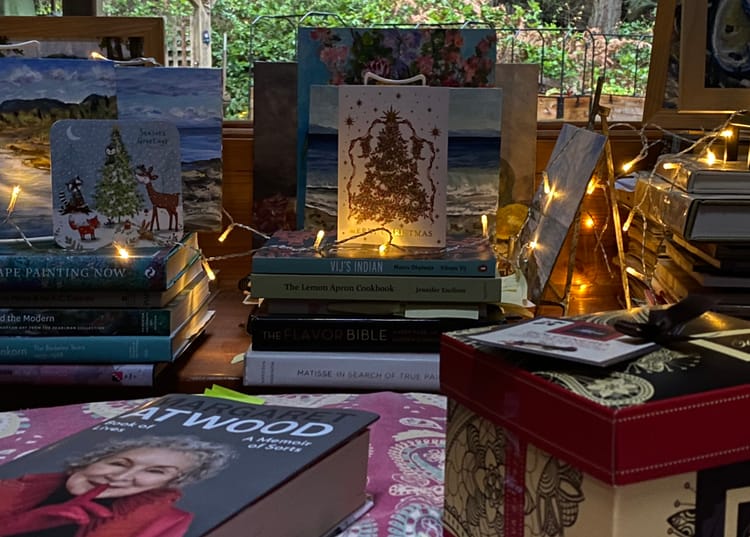

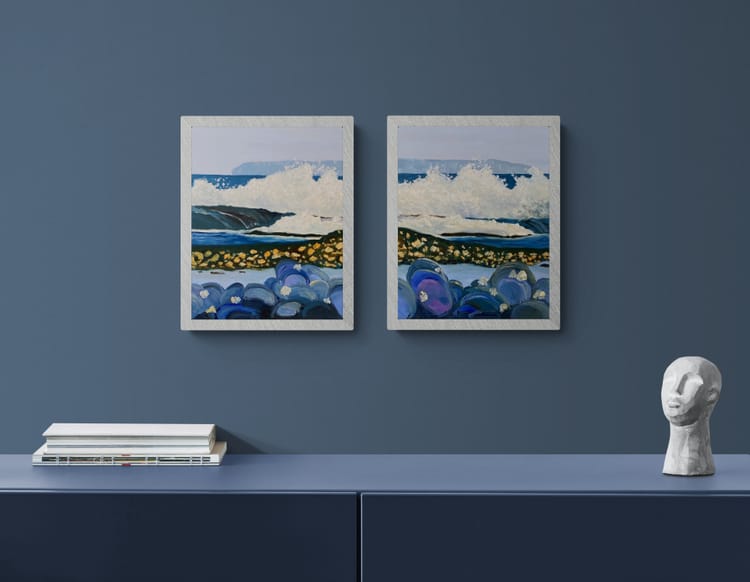
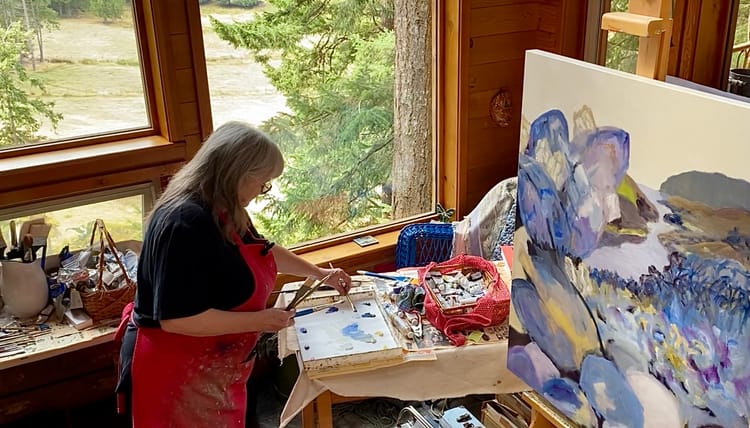
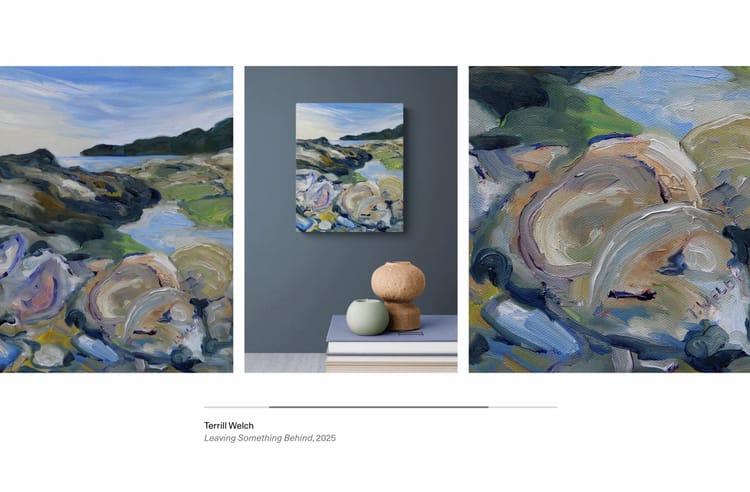
Member discussion